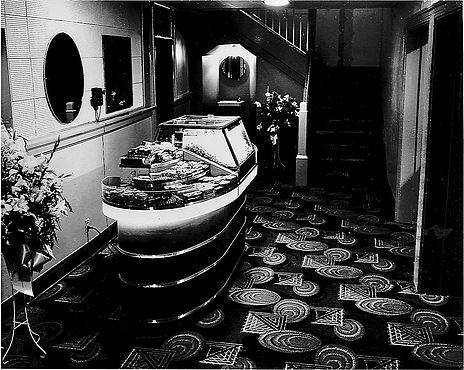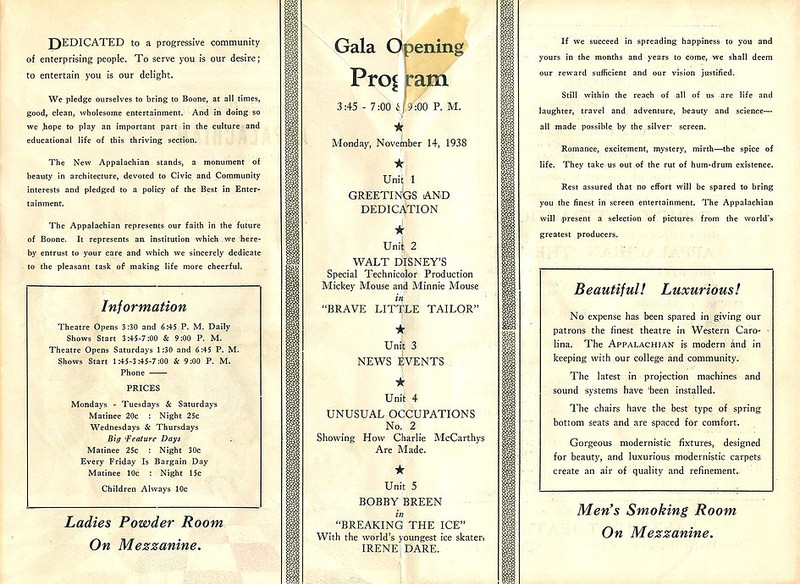Appalachian Theatre
Introduction
Text-to-speech Audio
Images
A look at the historic Appalachian Theatre

The glamorous green, white, & Black theater interior.

"No expense has been spared," declares the theater's opening gala program in 1938.

Backstory and Context
Text-to-speech Audio
The Appalachian Theatre was a vibrant social place and an indicator of change over time in mountainous Boone. W.R. Winkler and Arthur Hamby built the theater in 1938, but Winkler had actually operated earlier movie businesses in Boone. Winkler started Boone’s first movie-showing business in 1919 by “playing films on the walls of the Watauga County Courthouse with a projector”.1 The first ever projected motion picture in Watauga County was shown in 1905 by a professor from Tennessee, and as early as 1892 still picture projection “magic lantern” shows and storytelling events took place in an older courthouse building.2
Larger western North Carolina cities just down the mountain--Lenoir, Hickory, and Wilkesboro-- had cinemas beginning in 1905.3 Winkler and Hamby believed Boone could match those cities’ grandeur, and the dramatic appearance of the Appalachian Theatre in 1938 did not suggest otherwise.
When the theater first opened, it was the only Art Deco building in Watauga County. It had 999 seats due to an increased tax that would have been applied had there been 10004. The theater featured lime green, white and Black tiles and a large marquee illuminated with hundreds of red, yellow and white lights.
Up until the 1930s Boone had been no larger or more prominent than nearby towns like Shulls Mills, which had the first building in Watauga County dedicated specifically to playing movies.5 When the Appalachian Theatre opened, it truly set Boone apart and established the town as the central place in the area. In this growing town, the theater was the cultural hub, located in the heart of downtown. The theater showed movies and hosted live performances such as Vaudeville shows, musical groups, beauty contests, stage plays, minstrel shows, and other community acts.6 Headline live performers included the Foggy Mountain Boys, Minnie Pearl, and Watauga County folk guitar hero Doc Watson.
On January 21, 1950 there was a devastating fire that caused the theater to close its doors. The fire was said to have been caused by a teenage male employee who left an open-flame popcorn popper unattended while chatting with a female concessions worker. Rumors claimed that the popcorn attendant was trying to set up a date with her. Meanwhile, the unwatched popper burst into flames and the theater had to be evacuated. The fire caused the theater’s magnificent original tiered ceiling to collapse, but Winkler was determined to see his theater survive. He hired an architect to design renovations, and in the ensuing redesign Winkler changed the ceiling to a barrel vault style and added an addition to the front of the theater’s stage to accommodate a larger cinema screen, ending the theater’s ability to host live performances.7
In 1976 the building was leased to Essantee Theatres. The new ownership installed a second screen in the balcony and renamed the theatre “The Appalachian Twin”. When a new multiplex opened in Boone, the Twin began playing discounted late-run movies to respond to the competition. In 1986 Essantee was purchased by Carmike Cinemas, which took over operations of the theater until it was closed and boarded up in 2007.
In 2011 The Town of Boone purchased the theater building from a developer as part of a bankruptcy proceeding. The Appalachian Theatre of the High Country, a local non-profit organization purchased the building from the town of Boone in 2014. The organization, with help from the Downtown Boone Development Association, is currently restoring the building and theater to its original glory. In restoring the theater they hope to preserve the rich history of the building and transform it back into one of the High Country’s premiere arts and cultural venues. The building, although unfinished, is open for tours of small groups led by members and volunteers of Appalachian Theatre of the High Country. The theater is expected to re-open by 2018.
Sources
2 Boye, Gary R. “Before the Appalacian Theatre, Part 1: Courthouse Theater to 1919,” The Appalachian Theatre of the High Country. December 8, 2014. Accessed October 24, 2016. http://www.savetheapptheatre.com/single-post/ 2014/12/08/Before-the-Appalacian-Theatre-Part-1-Courthouse-Theater-to-1919.
3 Ibid.
4 Audrey Thomas, “Monday, November 14, 1938: The Appalachian Theatre Opens,” The Appalachian Theatre of the High Country. November 13, 2014. Accessed October 3, 2016. http://www.savetheapptheatre.com/single-post/ 2014/11/13/Monday- November-14-1938-The-Appalachian-Theatre- Opens.
5 Boye, Gary. “Before the Appalachian Theatre, Part 3: Film Exhibition in Watauga County Outside of Boone,” The Appalachian Theatre of the High Country. November 1, 2014. Accessed November 12, 2016. http://www.savetheapptheatre.com/single-post/2015/01/07/Before-the-Appalachian-Theatre-Part-3-Film-Exhibition-in-Watauga-County-Outside-of-Boone-.
6 Craig Fischer, Frank Mohler, and Eric Plaag, “A Brief History of the Appalachian Theatre,” The Appalachian Theatre of the High Country. November 1, 2014. Accessed October 3, 2016. http://www.savetheapptheatre.com/single-post/ 2014/11/01/A-Brief- History-of-the-Appalachian-Theatre.
7 Aleah Warner, “Saving the Appalachian Theatre.” The Appalachian, March 22, 2016. http://theappalachianonline.com /2016/03/22/revisiting-appalachian-theatre/.
Image credit Appalachian Theatre of the High Country, Boone, NC. November 1, 2014. Accessed November 12, 2016. http://www.savetheapptheatre.com/single-post/2014/11/ 01/A-Brief-History-of-the-Appalachian-Theat
Image Credit Gala Opening Program. Appalachian Theatre of the High Country, Boone, NC. November 1, 2014. Accessed November 12, 2016. http://www.savetheapptheatre.com/single-
